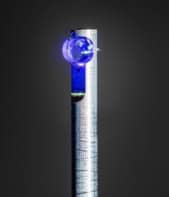With the 2019 Nobel Prize for Physics due to be announced on Tuesday 8 October, Physics World journalists pick their favourite Nobel awards from the past. Susan Curtis argues the case for the 2001 prize, which was awarded for the first experiments on Bose–Einstein condensates

It’s difficult to pick one favourite Nobel prize among the many achievements that have been honoured over the years, but my personal choice is the 2001 award – which went jointly to Eric Cornell, Wolfgang Ketterle and Carl Wieman for creating and understanding the first Bose–Einstein condensates (BECs). This new form of matter, in which a group of atoms behave as a single particle, was described by the Nobel committee as making the atoms “sing in unison”.
Wieman and Cornell made the first condensate in 1995 at JILA in Boulder, Colorado, by cooling a cloud of 2000 rubidium atoms to within a whisper of absolute zero. Ketterle and his group at MIT created a larger condensate of sodium atoms just a few months later, and then used their experimental set-up to demonstrate interference between two separate BECs as well as a rudimentary atom laser.
This experimental breakthrough was captured by an iconic image that is forever associated with BECs. The image, produced by Cornell and Wieman, records the velocity-distribution data of the rubidium atoms as they are cooled towards absolute zero, and clearly shows how atoms with different energies eventually condense into a distinct quantum state.

To me, this bears all the hallmarks of a classic Nobel prize. The award recognizes an experimental tour-de-force that proves a long-standing theoretical prediction – the existence of BECs as a fifth state of matter was first proposed by Einstein back in 1924, building on a paper by Satyendra Nath Bose – and the early experiments ignited a revolution in ultracold atomic physics that has enabled new research in areas as diverse as quantum physics, precision measurement and cosmology. Since then condensates have also been created with fermions, a much trickier proposition because these particles do not like to occupy the same quantum state as their neighbours, as well as with molecules and photons.
It’s much easier to create a BEC these days, but condensates can only be sustained for a fraction of a second on Earth due to the effects of gravity. Physicists have therefore looked to space, and in 2018 a Bose–Einstein condensate of 105 atoms was created in a rocket, allowing more than 100 experiments to be conducted during a six-minute freefall that preserved the BEC in zero-gravity conditions. The International Space Station is also now equipped with a Cold Atom Laboratory that will allow scientists to generate and study BECs for up to 10 seconds at a time.
I have a personal reason for choosing this prize too. I joined Physics World back in 1994 as a fairly recent physics graduate, and this result was announced just a few months later. Among all the latest research I was getting to grips with, this breakthrough stood out as being a beautifully simple result – perhaps because of that image – but one that goes to heart of our understanding of fundamental physics. I was really pleased when, two years later, I was able to work with Wolfgang Ketterle on an article for Physics World about the discovery of BECs and the latest research findings – which is still available to read today.
Physics World‘s Nobel prize coverage is supported by Oxford Instruments Nanoscience, a leading supplier of research tools for the development of quantum technologies, advanced materials and nanoscale devices. Visit nanoscience.oxinst.com to find out more.




